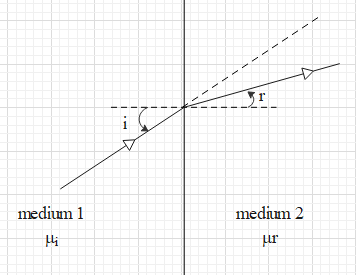
Write down Snell’s law of refraction and explain.
Answer
572.1k+ views
Hint: When a light ray passes from one medium into a different medium the light bends. This is called refraction. Snell’s law of refraction gives us the relation between the refractive indices of the two mediums and the angles of incidence and refraction.
Complete step by step answer:
Let us first understand what is meant by refraction of light. Refraction is the phenomenon of bending of a light ray when it passes from one medium into another medium, at the interface of the two mediums.
Light travels with a certain speed in a given medium. When light enters into a different medium, its speed changes. As a result, the ray of light appears to bend at the interface of the two mediums.
We understand the amount of bending of a light ray by Snell's law.
The Snell’s law states that ${{\mu }_{i}}\sin i={{\mu }_{r}}\sin r$.
Here, ${{\mu }_{i}}$ is the refractive of the medium in which the light ray is incident, ${{\mu }_{r}}$ is the refractive index of the medium in which the light ray enters after refraction. i and r are the angles of incidence and refraction as shown.

Refractive index of a medium is defined as the ratio of the speed of light in that medium to the speed of light in vacuum.
i and r are the angles that the incident ray and refracted ray make with the normal drawn at the interface, respectively.
Note: Note that when the light passes from a rarer medium into a denser medium, the angle of incidence is greater than the angle of refraction.
Whereas when the light passes from a denser medium into a rarer medium, the angle of incidence is lesser than the angle of refraction.
Complete step by step answer:
Let us first understand what is meant by refraction of light. Refraction is the phenomenon of bending of a light ray when it passes from one medium into another medium, at the interface of the two mediums.
Light travels with a certain speed in a given medium. When light enters into a different medium, its speed changes. As a result, the ray of light appears to bend at the interface of the two mediums.
We understand the amount of bending of a light ray by Snell's law.
The Snell’s law states that ${{\mu }_{i}}\sin i={{\mu }_{r}}\sin r$.
Here, ${{\mu }_{i}}$ is the refractive of the medium in which the light ray is incident, ${{\mu }_{r}}$ is the refractive index of the medium in which the light ray enters after refraction. i and r are the angles of incidence and refraction as shown.

Refractive index of a medium is defined as the ratio of the speed of light in that medium to the speed of light in vacuum.
i and r are the angles that the incident ray and refracted ray make with the normal drawn at the interface, respectively.
Note: Note that when the light passes from a rarer medium into a denser medium, the angle of incidence is greater than the angle of refraction.
Whereas when the light passes from a denser medium into a rarer medium, the angle of incidence is lesser than the angle of refraction.
Recently Updated Pages
A man running at a speed 5 ms is viewed in the side class 12 physics CBSE

The number of solutions in x in 02pi for which sqrt class 12 maths CBSE

State and explain Hardy Weinbergs Principle class 12 biology CBSE

Write any two methods of preparation of phenol Give class 12 chemistry CBSE

Which of the following statements is wrong a Amnion class 12 biology CBSE

Differentiate between action potential and resting class 12 biology CBSE

Trending doubts
What are the major means of transport Explain each class 12 social science CBSE

Which are the Top 10 Largest Countries of the World?

Draw a labelled sketch of the human eye class 12 physics CBSE

Explain sex determination in humans with line diag class 12 biology CBSE

Explain sex determination in humans with the help of class 12 biology CBSE

Differentiate between homogeneous and heterogeneous class 12 chemistry CBSE




